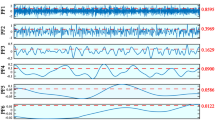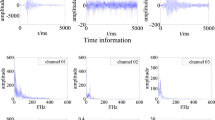Abstract
In active underground mining environments, monitoring mine vibrations has important implications for both safety and productivity. Microseismic data processing is crucial for subsurface real-time monitoring during mineral mining processes. Microseismic events are difficult to detect due to their small magnitudes and low signal-to-noise ratios (SNRs). Useful microseismic signals are usually obscured by long-period microseisms, random noise and artificial strong noise. We propose a useful microseismic denoising algorithm based on the normal time–frequency transform (NTFT) to determine the instantaneous frequency, amplitude and phase information from useful microseismic signals. The energy difference in the time–frequency domain between useful microseismic signals and strong noise is small. Therefore, based on the different phase characteristics of microseismic signals and noise in the NTFT phase spectrum, noise can be filtered out by reconstructing the microseismic signals in useful real-time frequency bands. The proposed simple bandpass filtering (SBPF) method is advantageous because the denoising result does not produce phase shifts, energy leakage or artefacts. The only parameter of the proposed method that needs to be defined is the instantaneous cutoff frequency; thus, the denoising operation is simple. We use both synthetic and real data to demonstrate the feasibility of the method for denoising complicated microseismic datasets.














Similar content being viewed by others
References
Ardhuin F, Gualtieri L, Stutzmann E (2015) How ocean waves rock the Earth: two mechanisms explain microseisms with periods 3 to 300 s. Geophys Res Lett 42(3):765–772
Bai M, Wu J (2017) Efficient deblending using median filtering without correct normal moveout-with comparison on migrated images. J Seism Explor 26:455–479
Battista B, Knapp C, McGee T, Goebel V (2007) Application of the empirical mode decomposition and Hilbert-Huang transform to seismic reflection data. Geophysics 72(2):H29–H37
Cai S, Liu L, Wang G (2018) Short-term tidal level prediction using normal time-frequency transform. Ocean Eng 156(15):489–499
Chai H, Huang H, Yan Z, Zhang X, Li Y, Gan P, Huang Y (2018) Multi-threshold wavelet packet-based method to attenuate noise from seismic signal. In: 7th international conference on informatics, environment, energy and applications, pp 212–216
Chen Y (2016) Dip-separated structural filtering using seislet thresholding and adaptive empirical mode decomposition based dip filter. Geophys J Int 206(1):457–469
Chen Y (2018) Non-stationary least-squares complex decomposition for microseismic noise attenuation. Geophys J Int 213(3):1572–1585
Chen Y (2020) Automatic microseismic event picking via unsupervised machine learning. Geophys J Int 222(3):1750–1764
Cheng S, Li S, Li L, Shi S, Zhou Z, Wang J (2018) Study on energy band characteristic of microseismic signals in water inrush channel. J Geophys Eng 15(5):1826–1834
Cheng W, Liu L, Wang G (2021) A new method for estimating the correlation of seismic waveforms based on the NTFT. Geophys J Int 226(1):368–376
Daubechies I, Lu J, Wu H (2011) Synchrosqueezed wavelet transforms: an empirical mode decomposition-like tool. Appl Comput Harmon Anal 30:243–261
Gong J, Li Y, Wu N, Li M (2019) Automatic time picking of microseismic data based on shearlet-AIC algorithm. J Seismol 23(2):261–269
Gu S, Zhang W, Jiang B, Hu C (2019) Case of rock burst danger and its prediction and prevention in tunneling and mining period at an irregular coal face. Geotech Geol Eng 37(4):2545–2564
He H, Chen Y, Lan B (2021) Damage assessment for structure subjected to earthquake using wavelet packet decomposition and time-varying frequency. Structures 34:449–461
Huang N, Shen Z, Long S, Wu M, Shih H, Zheng Q, Yen N, Tung C, Liu H (1998) The empirical mode decomposition and the Hilbert spectrum for nonlinear and non-stationary time series analysis. Proc R Soc A 454(1971):903–995
Huang W, Wang R, Zhang M, Chen Y, Yu J (2015) Random noise attenuation for 3D seismic data by modified multichannel singular spectrum analysis. In: 77th EAGE conference and exhibition 2015, European Association of Geoscientists & Engineers, (1): 1–5
Huang W, Wang R, Yuan Y, Zhou Y, Chen Y (2016) Randomized-order multichannel singular spectrum analysis for simultaneously attenuating random and coherent noise. In: 86th annual international meeting SEG, pp 4777–4781
Huang W, Wang R, Chen X, Zhou Y, Chen Y, You J (2017) Low-frequency noise attenuation of seismic data using mathematical morphological filtering. In: SEG technical program expanded abstracts, pp 5011–5016
Iqbal N (2022) DeepSeg: deep segmental denoising neural network for seismic data. IEEE Trans Neural Netw Learn Syst. https://doi.org/10.1109/TNNLS.2022.3205421
Iqbal N, Zerguine A, Kaka S, Al-Shuhail A (2016) Automated SVD filtering of time-frequency distribution for enhancing the SNR of microseismic/microquake events. J Geophys Eng 13(6):964–973
Iqbal N, Al-Shuhail A, Kaka S, Liu E, Raj A, McClellan J (2017) Iterative interferometry-based method for picking microseismic events. J Appl Geophys 140:52–61
Iqbal N, Liu E, McClellan J, Al-Shuhail A, Kaka S, Zerguine A (2018) Detection and denoising of microseismic events using time–frequency representation and tensor decomposition. IEEE Access 6:22993–23006
Laske G, Masters G, Ma Z, Pasyanos M (2013) Update on CRUST1.0—a 1-degree global model of Earth’s crust. In: Geophysical research abstracts. Vienna, Austria: EGU General Assembly. 15(15): 2658
Li P, Feng X, Feng G, Xiao Y, Chen B (2019a) Rockburst and microseismic characteristics around lithological interfaces under different excavation directions in deep tunnels. Eng Geol 260:105209
Li S, Cheng S, Li L, Shi S, Zhang M (2019b) Identification and location method of microseismic event based on improved STA/LTA algorithm and Four-Cell-Square-Array in plane algorithm. Int J Geomech 19(7):04019067
Li L, Tan J, Schwarz B, Staněk F, Poiata N, Shi P, Diekmann L, Eisner L, Gajewski D (2020) Recent advances and challenges of waveform-based seismic location methods at multiple scales. Rev Geophys 58:1–47
Liu R (2021) Research on feature fusion method of mine microseismic signal based on unsupervised learning. Shock Vib 2021:1–12
Liu L, Hsu H (2012) Inversion and normalization of time-frequency transform. Appl Math Inf Sci 6(1S):67–74
Liu L, Hsu H, Grafarend E (2007) Normal Morlet wavelet transform and its application to the Earth’s polar motion. J Geophys Res. https://doi.org/10.1029/2006JB004895
Liu W, Cao S, Chen Y (2016) Applications of variational mode decomposition in seismic time-frequency analysis. Geophysics 81(5):V365–V378
Liu E, Zhu L, Raj A, McClellan J, Al-Shuhail A, Kaka S, Iqbal N (2017) Microseismic events enhancement and detection in sensor arrays using autocorrelation-based filtering. Geophys Prospect 65(6):1496–1509
Liu N, Yang Y, Li Z, Gao J, Pan S (2020) Seismic signal de-noising using time–frequency peak filtering based on empirical wavelet transform. Acta Geophys 68(2):1–10
Long Y, Lin J, Li B, Wang H, Chen Z (2019) Fast-AIC method for automatic first arrivals picking of microseismic event with multitrace energy stacking envelope summation. IEEE Geosci Remote Sens Lett 17(10):1832–1836
Longuet-Higgins M (1950) A theory of the origin of microseisms. Philos Trans Royal Soc Lond Ser A Math Phys Sci 243(857):1–35
Maeda N (1985) A method for reading and checking phase time in autoprocessing system of seismic wave data. Zisin 38(3):365–379
Mousavi S, Langston C, Horton S (2016) Automatic microseismic denoising and onset detection using the synchrosqueezed continuous wavelet transform. Geophysics 81(4):V341–V355
Naghadeh D, Morley C (2016) Wavelet extraction and local seismic phase correction using normalized first-order statistics. J Seism Explor 25(2):163–176
Othman A, Iqbal N, Hanafy S, Waheed U (2021) Automated event detection and denoising method for passive seismic data using residual deep convolutional neural networks. IEEE Trans Geosci Remote Sens 60:1–11
Rajaeitabrizi Y, Salehiozoumchelouei R, D’Auria L, Sánchez de la Rosa J (2018) Enhancing microearthquake detection through non-linear filtering. In: EGU General Assembly Conference Abstracts, pp 3400
Song F, Kuleli HS, Toksöz MN, Ay E, Zhang H (2010) An improved method for hydrofracture-induced microseismic event detection and phase picking. Geophysics 75(6):A47–A52
Vaezi Y, Baan M (2015) Comparison of the STA/LTA and power spectral density methods for microseismic event detection. Geophys J Int 203(3):1896–1908
Wessel P, Smith W (1995) New version of the generic mapping tools released. EOS Trans Am Geophys Union 76(33):329
Yang H, Zhou P, Fang N, Zhu G, Xu W, Su J, Meng F, Chu R (2020) A shallow shock: the 25 February 2019 ML 4.9 earthquake in the Weiyuan shale gas field in Sichuan, China. Seismol Res Lett 91(6):3182–3194
Zhang X, Jia R, Lu X, Peng Y, Zhao W (2018) Identification of blasting vibration and coal-rock fracturing microseismic signals. Appl Geophys 15(2):280–289
Zhu L, Rivera L (2002) A note on the dynamic and static displacements from a point source in multilayered media. Geophys J Int 148(3):619–627
Zuo L, Sun H, Mao C, Liu Y, Jia R (2019) Noise suppression method of microseismic signal based on complementary ensemble empirical mode decomposition and wavelet packet threshold. IEEE Access 7:176504–176513
Acknowledgements
This work was supported by the National Natural Science Foundation of China (Grant No. 42074011). We appreciate Yongqian Shao of the Earthquake Administration of Shanghai Municipality for graciously supplying the data used in this work. We used GMT software to prepare the figures (Wessel and Smith 1995).
Author information
Authors and Affiliations
Contributions
The first author Yanji Yao wrote this paper and the data processing code. Guocheng Wang and Lintao Liu revised the manuscript. All authors have read and agreed to the published version of the manuscript.
Corresponding author
Ethics declarations
Conflict of interest
No conflict of interest exists in the submission of this manuscript, and the manuscript is approved by all authors for publication.
Additional information
Edited by Dr. Rafał Czarny (ASSOCIATE EDITOR) / Prof. Gabriela Fernández Viejo (CO-EDITOR-IN-CHIEF).
Rights and permissions
Springer Nature or its licensor (e.g. a society or other partner) holds exclusive rights to this article under a publishing agreement with the author(s) or other rightsholder(s); author self-archiving of the accepted manuscript version of this article is solely governed by the terms of such publishing agreement and applicable law.
About this article
Cite this article
Yao, Y., Wang, G. & Liu, L. Microseismic signal denoising using simple bandpass filtering based on normal time–frequency transform. Acta Geophys. 71, 2217–2232 (2023). https://doi.org/10.1007/s11600-022-01012-1
Received:
Accepted:
Published:
Issue Date:
DOI: https://doi.org/10.1007/s11600-022-01012-1




